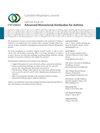Clinical Burden of Chronic Obstructive Pulmonary Disease in Patients with Suboptimal Peak Inspiratory Flow
IF 2.1
4区 医学
Q3 RESPIRATORY SYSTEM
引用次数: 0
Abstract
Introduction. Many patients with chronic obstructive pulmonary disease (COPD) may derive inadequate benefit from dry powder inhalers (DPIs) because of suboptimal peak inspiratory flow (sPIF). Objectives. To assess the clinical burden of COPD by characterizing the clinical characteristics of participants with sPIF against medium-low resistance DPIs versus those with optimal PIF (oPIF) from two phase 3 clinical trials. Methods. Baseline data were collected from two randomized, controlled, phase 3 trials (NCT03095456; NCT02518139) in participants with moderate-to-severe COPD. oPIF (60 L/min) against the medium-low resistance DPIs was used as the threshold for defining the PIF subgroups (<60 L/min (sPIF) vs ≥60 L/min (oPIF)). Results. Most participants included in this analysis were White (92%) and male (63%); the mean (range) age was 65 (43–87) years. Participants with sPIF had significantly greater dyspnea than those with oPIF as measured using the modified Medical Research Council scoring (mean (95% CI): 2.1 (2.0–2.2) vs 1.6 (1.4–1.7); ) and baseline dyspnea index (mean (95% CI): 5.1 (4.9–5.4) vs 6.1 (5.8–6.3); ). Based on COPD Assessment Test scores, participants with sPIF had a higher COPD symptom burden than those with oPIF (mean (95% CI): 21.5 (19.7–23.3) vs 19.5 (18.6–20.4); 5). Conclusion. In these trials, participants with COPD who had sPIF against the medium-low resistance DPIs had more dyspnea and worse health status than those with oPIF. These results demonstrate that sPIF is associated with a higher clinical burden as measured by patient-reported outcomes.峰值吸气流量不达标患者的慢性阻塞性肺病临床负担
简介。许多慢性阻塞性肺病(COPD)患者由于吸气峰值流量(sPIF)不达标,可能无法从干粉吸入器(DPI)中获得足够的益处。目的:评估慢性阻塞性肺病的临床负担。通过分析两项三期临床试验中使用中低阻力干粉吸入器的 sPIF 患者与使用最佳吸入峰值流量 (oPIF) 患者的临床特征,评估慢性阻塞性肺病的临床负担。研究方法以针对中低阻力DPIs的oPIF(60 L/min)作为阈值来定义PIF亚组(<60 L/min (sPIF) vs ≥60 L/min (oPIF))。结果。参与分析的大多数参与者为白人(92%)和男性(63%);平均年龄(范围)为 65(43-87)岁。根据修改后的医学研究委员会评分(平均值(95% CI):2.1 (2.0-2.2) vs 1.6 (1.4-1.7);)和基线呼吸困难指数(平均值(95% CI):5.1 (4.9-5.4) vs 6.1 (5.8-6.3);),sPIF 参与者的呼吸困难程度明显高于 oPIF 参与者。根据慢性阻塞性肺病评估测试评分,sPIF 参与者的慢性阻塞性肺病症状负担高于 oPIF 参与者(平均值(95% CI):21.5 (19.7-23.3) vs 19.5 (18.6-20.4);5)。结论在这些试验中,与使用 oPIF 的慢性阻塞性肺病患者相比,使用中低阻力 DPIs 的慢性阻塞性肺病患者呼吸困难更严重,健康状况更差。这些结果表明,从患者报告的结果来看,sPIF 与更高的临床负担相关。
本文章由计算机程序翻译,如有差异,请以英文原文为准。
求助全文
约1分钟内获得全文
求助全文
来源期刊

Canadian respiratory journal
医学-呼吸系统
CiteScore
4.20
自引率
0.00%
发文量
61
审稿时长
6-12 weeks
期刊介绍:
Canadian Respiratory Journal is a peer-reviewed, Open Access journal that aims to provide a multidisciplinary forum for research in all areas of respiratory medicine. The journal publishes original research articles, review articles, and clinical studies related to asthma, allergy, COPD, non-invasive ventilation, therapeutic intervention, lung cancer, airway and lung infections, as well as any other respiratory diseases.
 求助内容:
求助内容: 应助结果提醒方式:
应助结果提醒方式:


